The Complete Leopard Gecko Care Sheet
February 18, 2021
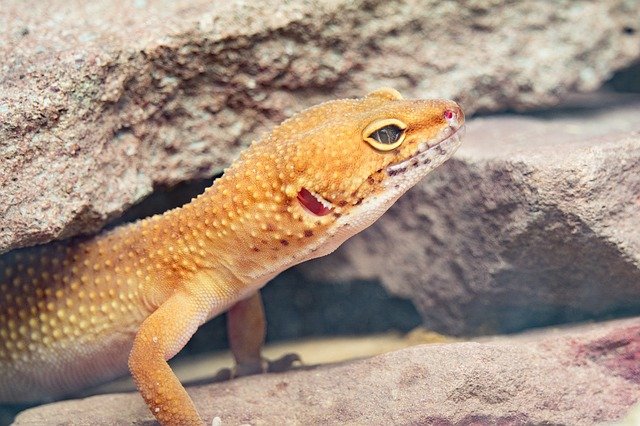
Table Of Contents
- Leopard Gecko Enclosure
- Leopard Gecko Substrate
- Leopard Gecko Lighting
- Leopard Gecko Temperature
- Leopard Gecko Humidity
- Feeding your Leopard Gecko
- Handling your Leopard Gecko
Caring for your Leopard Gecko
Leopard geckos are docile lizards that are full of personality, and make excellent beginner reptiles. In the wild, leopard geckos are found in the semi-desert and arid grasslands of Afghanistan, India, Pakistan, and Nepal. Wild leopard geckos are oftentimes tan with black spots — allowing them to blend into their natural surroundings. Captive bred leopard geckos come in a wide variety of colors and patterns (called morphs), so be sure to thoroughly check out all of your options before settling on one! These geckos typically grow to be between 7-10 inches long (females are typically on the smaller end of this spectrum, and males are on the larger end). In captivity leopard geckos tend to live 15-20 years.
Leopard Gecko Enclosure
Leopard geckos are active lizards that love to explore, and they need the room to do so. Baby leopard geckos can be started out in a 20 gallon enclosure, but you will need to be prepared to upgrade that enclosure as your lizard grows. Adult leopard geckos require an enclosure that is at least 36 inches X 18 inches X 18 inches. If you want to save time and money, I recommend skipping the 20 gallon enclosure and putting your juvenile leopard gecko into the adult size tank. If you go this route you will need to provide them with lots of clutter and decor, as open spaces tend to stress them out. Leopard geckos need at least 2 hides: one on the cool end of the tank, and one on the warm side. This hide from Chewy is not only aesthetically pleasing, but its also perfect for a leopard gecko!
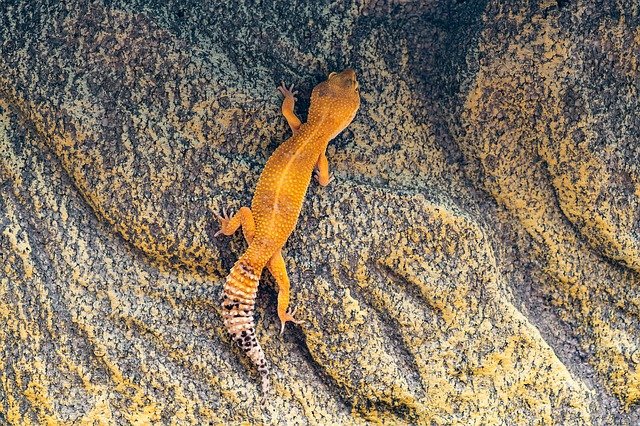
How often Should I Clean my Leopard Gecko’s Enclosure?
You should check your leopard gecko’s enclosure daily and spot clean when necessary. If waste is left to sit in the enclosure, it can encourage the spread of bacteria and mold growth. Once a month you should take everything out of the enclosure and deep clean it with a diluted bleach water solution. Check to see if your leopard gecko’s accessories are dishwasher safe. If they aren’t, you can hand wash them with dawn dish soap. Be sure to thoroughly rinse the enclosure before putting your leopard gecko back into it.
Leopard Gecko Substrate
Leopard geckos should be provided with a substrate that is non-toxic, easy to maintain, and has no risk for impaction. You should NEVER supply your leopard gecko with any kind of loose substrate. Substrates like sand and soil can cause impaction when digested which can lead to several health issues, and in extreme cases, can lead to death. Many commercial soils also contain fertilizer and pesticides, which can poison your gecko. The best leopard gecko substrate is tile. These hold heat well and are very easy to clean, and they can be found in hardware stores. Some other good options for a leopard gecko’s substrate are reptile carpet (if used you will want two pieces to switch between for easy cleaning), paper towels, and reptile sand mats (the sand is glued to the mat so there is no risk of impaction, but it can make cleaning difficult). You can find reptile carpet here on Chewy. This carpet is large enough for a 50 gallon tank, which will be more than enough for an adult leopard gecko enclosure.
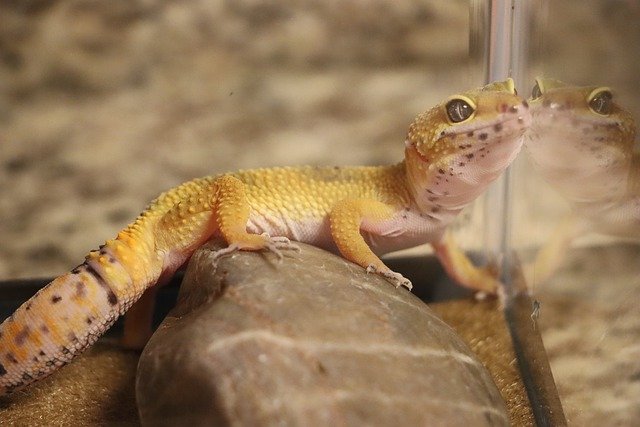
Leopard Gecko Lighting
Leopard geckos need a day and night cycle in captivity, just as they would have in the wild. Your leopard gecko’s lights should be on for 14 hours everyday, and off for the remaining 10 hours. You should have natural light coming in through the window as well, but make sure it is not shining directly into the tank. This can cause the temperatures in the tank to quickly rise, becoming deadly.
The Importance of UVB for Leopard Geckos
You must provide your leopard gecko with UVB lighting. In the wild, leopard geckos depend on the sun to provide them with UVB rays that will help them to synthesize vitamin D3, allowing them to absorb calcium. If your leopard gecko is not supplied with UVB lighting in captivity, you run the risk of them developing metabolic bone disease. Metabolic bone disease leaves your leopard gecko’s bones brittle and prone to fractures. Oftentimes the spine of the lizard will begin to warp, and in extreme cases, metabolic bone disease can lead to death.
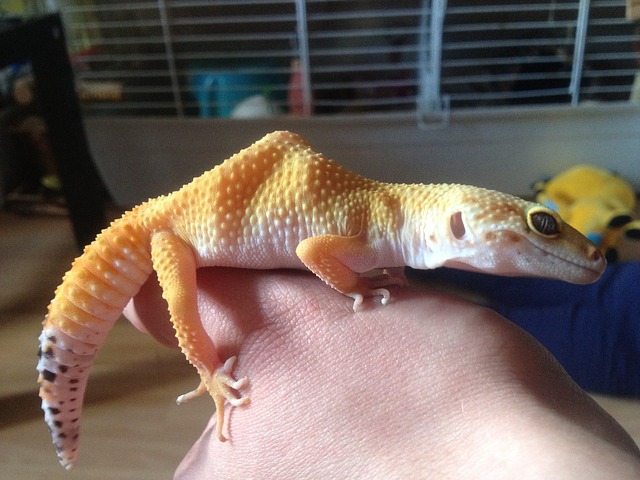
Leopard Gecko Temperature
Leopard geckos are cold blooded creatures, meaning they cannot control their own body temperature and rely on their surroundings to warm them up. However, this does not mean that their entire enclosure should be scorching hot. They should be provided with a temperature gradient throughout their enclosure, so they can comfortably move between temperatures. The warm side of your leopard gecko’s enclosure should stay between 87°F - 92°F. The cool side should stay between 73°F - 77°F. To monitor these temperatures, you should place a thermometer on both the hot and cool ends of their enclosure. It is important to choose a digital thermometer since they are more accurate than the analog ones.
A heat lamp is a good way to provide your leopard gecko with the heat during the day. The wattage bulb you will need will be determined by the temperature of the room your gecko is housed in. The colder the room, the higher the wattage. At night the temperature in your leopard gecko’s tank can safely drop into the 60s. If you notice the temperatures are getting colder than that at night, you may need to provide them with a heat mat or ceramic heat emitter. Stay away from colored night bulbs. These can disrupt your leopard gecko’s day and night cycle. Never use heat rocks, either. The heating mechanisms in these are unreliable, and have been known to get too hot and severely burn reptiles. I highly recommend purchasing a temperature gun to monitor accurate surface level temperatures throughout your leopard gecko’s enclosure.
Leopard Gecko Humidity
Since leopard geckos are native to a dry, semi-desert environment, they do not require a high humidity. The humidity in a leopard gecko’s enclosure should sit between 30% - 40%. You should have a hygrometer in their enclosure (many thermometers have a built in hygrometer) to get an accurate measure of the humidity levels. When your leopard gecko is shedding, you should provide them with a hide to hold humidity (don’t increase their tank's humidity during sheds because it can make them sick). You can do this by adding a second hide to the warm end of their tank and stuffing it with damp moss.
Feeding your Leopard Gecko
Leopard geckos are insectivores, meaning they only eat bugs. You do not need to supply your leopard gecko with any fruits or veggies. Baby leopard geckos should be fed every day, and adults should be fed every couple days. Leopard geckos should be fed 2 insects for every inch of your geckos total length. For example, a 6 inch leopard gecko would be fed 12 appropriately sized bugs 3 to 4 times a week. Insects fed to leopard geckos should be no bigger than the space between their eyes. Crickets, dubia roaches, mealworms, and silkworms are all excellent meal choices for your leopard gecko. Wax worms and butterworms are high in fat so they don’t make good meals, but they can be a good choice for a treat. Your leopard gecko should only be given treats once a week. It is important to offer your gecko a variety of different insects. This will help prevent nutrient deficiency, organ failure, and obesity. Leopard geckos can greatly benifit from vitamin D3 and calcium. Prior to feeding these insects to your leopard gecko, you should dust them in a calcium powder. Repashy is known for being an excellent brand, and it is available here on Chewy. If you would like to learn more about choosing the best feeder insects for your leopard gecko, I have an article on it here.
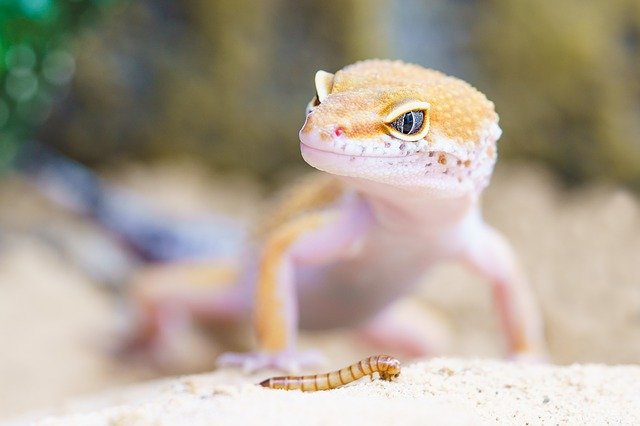
Handling your Leopard Gecko
Though it can be very tempting to hold your leopard gecko when you first bring them home, don’t. Instead, set them into their enclosure and let them get acquainted with their new surroundings. You should not handle them for at least a week. After a week has passed, if your leopard gecko is eating regularly, you can begin to handle them. If they are not eating regularly after 2 weeks has passed you should make an appointment with an exotic vet. NEVER pick them up by the tail, as they can detach them. You should support your leopard gecko’s whole body when handling them. Always wash your hands before and after handling them to prevent the spread of disease. I like to keep a bottle of sanitizer in my reptile room for easy sanitation between reptiles.
This post contains affiliate links that may pay me a commission when a sale is made. Affiliate commissions help me maintain this website, and I only recommend products that I trust.

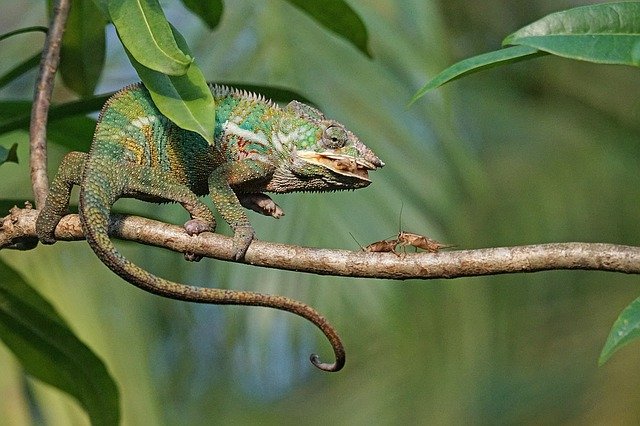



Sending...